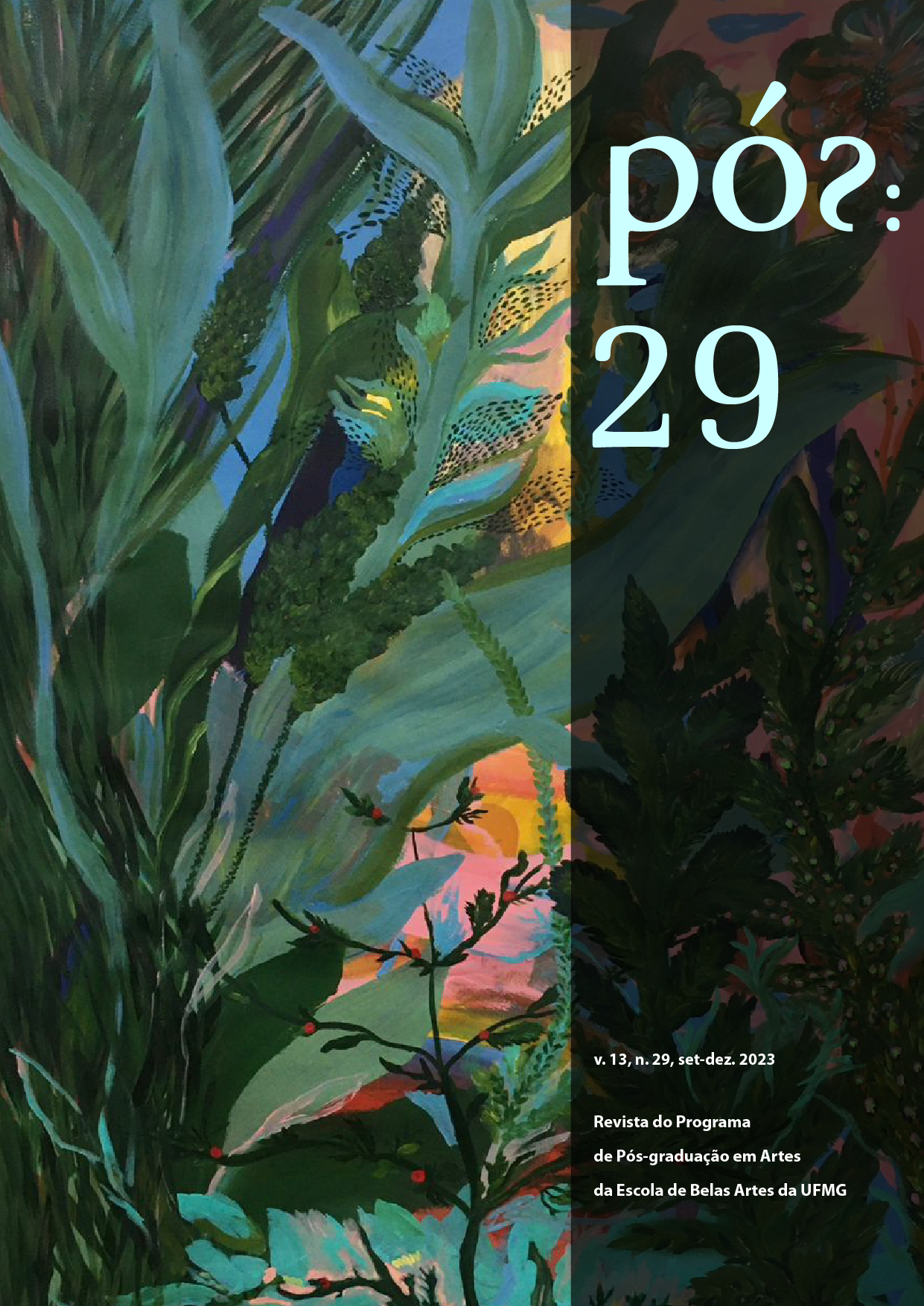"DO YOU KNOW WHO THIS WORK IS? NOW YOU KNOW!"
Tactical objections to the regime of black artistic expropriation
DOI:
https://doi.org/10.35699/2238-2046.2023.45686Keywords:
Urban art, Appropriation, Black artAbstract
Massive M.I.A’s intervention exposes a regime of exploitation/appropriation of the work of black artists for art. The paper makes a reading of the practices of artistic expropriation proposed by his action, when he wrote “Negro” on the glass of the photograph of his work/pixo “Olhai por nos”. The text argues about the embarrassment of the public in the face of the artist's performance and the strategies of circulation in the networks as a way of contesting the colonial expropriation regime of art and the creative and political-ideological work of black people. He invites us to identify ancestral Quilombist practices, such as resistance to the system and the resumption of space, with which in contemporary technology the artist seeks to expose the extractive regime that is reproduced in art.
References
AHMED, Sara. A Phenomenology of Whiteness. Feminist Theory, v. 8, n. 2, 2007, p.149-168. DOI: https://doi.org/10.1177/1464700107078139
ALMEIDA, Silvio Luiz de. Racismo estrutural. São Paulo: Pólen, 2019.
ARTS, MASSIVE ILEGAL (MIA). Perfil no Instagram (@negromia). Disponível em: . Acesso em: 10 março de 2023.
AZOULAY, Ariela. Toward the abolition of photography’s imperial rights. In Capitalism and the camera, por COLEMAN, Kevin; JAMES, Daniel. p. 72-128, Verso Books, 2021.
BALDIN, Vitoria. Os signos da cultura POP no grafite palestino circulação e ativismo digital em perspectiva. Esboços, v. 50, n. 29, p.133-151, 2022. DOI: https://doi.org/10.5007/2175-7976.2022.e82690
BENTES, Ivana. Redes Colaborativas e Precariado Produtivo. Revista Periferia, Rio de Janeiro, v. 1, n. 1, p. 53-61, jun., 2009. DOI: https://doi.org/10.12957/periferia.2009.3418
BERNARDINO-COSTA, Joaze; GROSFOGUEL, Ramón. Decolonialidade e perspectiva negra. Sociedade e Estado, v. 31, p. 15-24, 2016. DOI: https://doi.org/10.1590/S0102-69922016000100002
BOURRIAUD, Nicolas. Estética Relacional. São Paulo: Martins Fontes, 2009.
CAMPOS, Ricardo. A pixelização dos muros: graffiti urbano, tecnologias digitais e cultura visual contemporânea. Revista Famecos: mídia, cultura e tecnologia, v. 19, n. 2, p. 543-566, 2012. DOI: https://doi.org/10.15448/1980-3729.2012.2.12338
CAPRIGLIONE, Laura. Pichadores vandalizam escola para discutir conceito de arte. Folha de S.Paulo, 13 de junho de 2008. Disponível em: encurtador.com.br/egCT8 . Acesso em 22 jan. 2023.
CASIMIRO, Giovanna Graziosi. Curadoria digital urbana, rebelião monumental e a disrupção das narrativas patrimoniais em tempos de isolamento. Contemporânea-Revista do PPGART/UFSM, v. 3, n. 6, p. e6-e6, 2020. DOI: https://doi.org/10.5902/2595523362041
COUTO, Letícia Lima. Arte de rua em casa: O consumo de obras que remetem à pichação. Monografia de especialização em “Cultura Material e Consumo: perspectivas semiopsicanalíticas”, Escola de Comunicação e Artes ECA, USP, 2020.
DE CERTEAU, Michel. A invenção do cotidiano. 3ª edição. Petrópolis: Editora Vozes, 1998.
FERREIRA DA SILVA, D. Ler a arte como confronto. Logos, v. 27, n. 3, 2020. DOI: https://doi.org/10.12957/logos.2020.57382
GIOVANNI, Julia Ruiz Di. Artes de abrir espaço: apontamentos para a análise de práticas em trânsito entre arte e ativism. Cadernos de Arte e Antropologia, São Paulo, v. 4, n. 2, 2015. Disponível em: https://journals.openedition.org/cadernosaa/911 . Acesso em: 30 jan. 2023. DOI: https://doi.org/10.4000/cadernosaa.911
HALL, Stuart. Cultura e representação. Rio de Janeiro: PUC-Rio - Apicuri, 2016.
LARA, Priscila Mocelin Lara; VARELLA, Patrícia Camera. Pixação e o circuito artístico brasileiro: ambiguidades e convergências. Revista RUA, Campinas, SP, v. 28, n. 2, p. 391–403, set., 2022.
LARA, Priscila Mocelin; VARELLA, Patricia Camera. Pixação e o circuito artístico brasileiro: ambiguidades e convergências. RUA, v. 28, n. 2, 2022. DOI: https://doi.org/10.20396/rua.v28i2.8671112
LARA, Priscila Mocelin. Pixação e o circuito artístico brasileiro (2005-2021): disputas e novas possibilidades. Dissertação de Mestrado em História, UEPG, 2022.
LEAL, Gabriela; CAMPOS, Ricardo. Ocupando o cubo branco: reflexões sobre a entrada da pixação no mundo da arte. Revista de Antropologia, São Paulo, v. 65, n. 3, p. 1-25, out., 2022. DOI: https://doi.org/10.11606/1678-9857.ra.2022.197969
MEIRINHO, Daniel. Ressignificações contemporâneas dos imaginários racializados nas artes visuais. Revista Farol, 16(23), 55–70, 2021. DOI: https://doi.org/10.47456/rf.v1i23.34029
MIGNOLO, Walter. D. La opción decolonial: desprendimiento y apertura. Un manifiesto y un caso. Tabula Rasa, Bogotá, Colómbia, n. 8, p. 243-282, 2008. DOI: https://doi.org/10.25058/20112742.331
MOMBAÇA, Jota. A plantação cognitiva. MASP Afterall-Arte e Descolonização, 2020.
MOTEN, Fred; HARNEY, Stefano. Pretitude e governança. In: RIBEIRO, Felipe (org.). Atos de fala. Rio de Janeiro: Telemar, p. 27-33, 2016.
MOURA, C. Os Quilombos na Dinâmica Social do Brasil. Maceió: EDUFAL, 2001.
OLIVEIRA, Ana Karina. “Agora é a vez do pixo”: cenas de dissenso e subjetivação política nas relações entre pichação e arte. Dissertação (Mestrado em Comunicação Social) - Universidade Federal de Minas Gerais. Belo Horizonte, 2015.
QUIJANO, Anibal. Colonialidade, poder, globalização e democracia. Novos rumos, v. 37, n. 17, p. 4-28, 2002.
RAHME, Anna Maria Abrão Khoury. Tintas paulistanas: as cicatrizes da desigualdade. Revista ARA, v. 12, n. 12, p. 31-59, 2022. DOI: https://doi.org/10.11606/issn.2525-8354.v12i12p31-59
RANCIÈRE, Jacques. A partilha do sensível: Estética e política. Trad. Mônica Costa Netto. São Paulo: Editora 34, 2020.
RANCIÈRE, Jacques. El destino de las imágenes. Trad. Paulo Bustinduy. Pontevedra: Politopías, 2011.
RAPOSO, Paulo. “Artivismo”: articulando dissidências, criando insurgências, Cadernos de Arte e Antropologia, Vol. 4, n 2, p. 3-12, 2015. DOI: https://doi.org/10.4000/cadernosaa.909
RICHARDS, D. M. The African Aesthetic and National Consciousness. In: WELSH-AS-ANTE, K. (ed.). The African aesthetic: keeper of the traditions. London: Praeger, 1994.
RITCHIN, Fred. After Photography. Nova Iorque, W.W. Norton & Company, 2009.
ROLNIK, S. “Desentranhando futuros”.ComCiência, Campinas, n. 99, 2008. Disponível em: http://comciencia.scielo.br/scielo.php?script=sci_arttext&pid=S1519-76542008000200007&lng=pt&nrm=iso . acessos em 20 jan. 2023.
ROUILLÉ, André. A fotografia: entre documento e arte contemporânea. São Paulo: Editora Senac, 2009.
SAPHIRO, Roberta. Artification as Process. Cultural Sociology, Paris, v. 13, p. 265-275, 2019. DOI: https://doi.org/10.1177/1749975519854955
STABILE, Arthur. Foto que retrata obra de artista negro é vendida sem autorização do autor. Ponte Jornalismo (Ponte.Org), 11 de abril de 2019.
TUBAMOTO, Fernanda Tiemi. 'Olhai por Nóis': artista que pichou o Pateo do Collegio lança exposição. Jornal Estado de Minas, 09 de junho de 2022. Seção Arte de Rua.
VIEIRA, Anna Paula Ferraz Dias. O direito à cidade e a cultura marginal: a narratividade como luta por visibilidade. Dissertação (Mestrado em Arquitetura e Urbanismo) - Universidade Federal do Espírito Santo. Vitória, 2018.
Downloads
Published
How to Cite
Issue
Section
License
Copyright (c) 2023 Emanuele De Freitas Bazílio, Daniel Meirinho

This work is licensed under a Creative Commons Attribution-NonCommercial 4.0 International License.
Authors who publish in this journal agree to the following terms:
- Authors retain copyright and grant the journal the right of first publication, with the work simultaneously licensed under the a Creative Commons Attribution-NonCommercial 4.0 International License that permits sharing of the work with acknowledgement of authorship and initial publication in this journal;
- Authors are permitted to enter into additional contracts separately, for non-exclusive distribution of the version of the work published in this journal (e.g., the Creative Commons Attribution License).
- Authors are permitted and encouraged to publish and distribute their work online (e.g., in institutional repositories or on their home page) at any point before or during the editorial process, as this may generate productive changes as well as increase the impact and citation of the published work.
- It is the responsibility of the authors to obtain written permission to use in their articles materials protected by copyright law. Revista PÓS is not responsible for copyright breaches made by its contributors.












